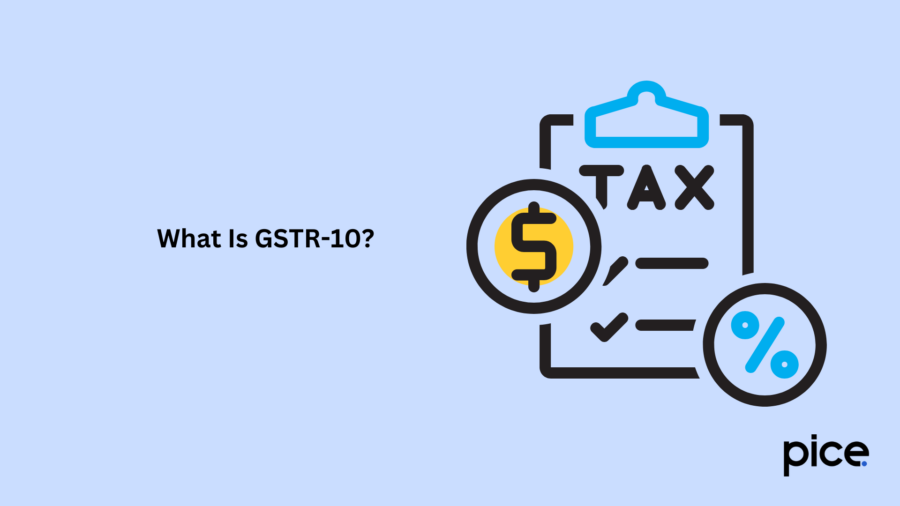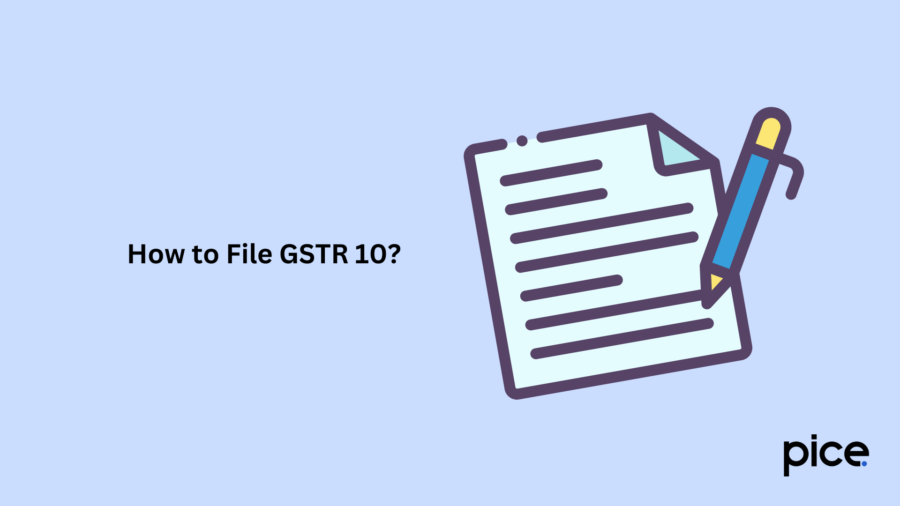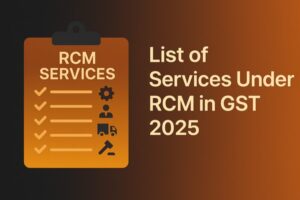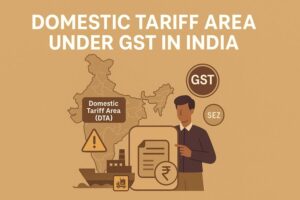GSTR 10 Return Filing: Late Fees, Due Date, Format & Rules
- 19 Feb 25
- 8 mins

GSTR 10 Return Filing: Late Fees, Due Date, Format & Rules
- What Is GSTR-10?
- Who Should File GSTR-10?
- Details to be Provided in GSTR-10
- What Is the Time Frame for Filing a GSTR 10 Return?
- What Are the Late Fees for Not Filing the GSTR-10 Form on Time?
- How to File GSTR 10?
- What Advantages Come with Filing GSTR-10?
- What is the Difference Between a Final Return and an Annual Return?
- Conclusion
Key Takeaways
- Mandatory for Cancellation – Required for voluntary GST registration cancellation.
- Time Frame – Must be filed within 3 months of cancellation.
- Stock & ITC – Closing stock and Input Tax Credit (ITC) must be declared.
- Late Fee – ₹100 CGST + ₹100 SGST per day (max 0.25% of turnover).
- Not an Annual Return – Only for GST cancellation, unlike GSTR-9.
The GST regime was introduced in 2017 to simplify the complexity of indirect taxes. According to its norms, filing returns depending on turnover and other criteria is mandatory for every taxpayer.
GSTR 10 is one such return. It is required when a taxpayer wishes to withdraw their registration. Cancellation of GST registration can be done voluntarily if the business is dormant or unable to process the required turnover.
Since GSTR 10 return is an indispensable element for GST deregistration, knowing its due date, advantages, format and more is crucial.
What Is GSTR-10?

GSTR 10, also known as the final return, serves as the formal closure of registration of a GST account. Taxpayers who intend to willingly cancel or surrender their GST registration must file GSTR 10. It reconciles the outstanding tax liabilities and taxes that have been paid before filing the final return.
GSTR 10 also stands as a statement of stocks held by taxpayers immediately preceding the date from which cancellation of GST registration was effective. This return aims to offer details of the Input Tax Credit (ITC) that has been involved in closing stock, whether it is input or capital goods, to be reversed or paid by the taxpayer.
Who Should File GSTR-10?
Form GSTR 10 must be compulsorily filed by normal taxpayers to wind up their GST profile, except:
- Persons needed to deduct tax at source (TDS) under Section 51
- Persons needed to collect tax at source (TCS) under Section 52
- Persons paying tax under Section 10 (Composition Taxpayer)
- Non-resident taxable persons
- Input Service Distributor
Details to be Provided in GSTR-10
GSTR 10 comprises 11 sections. While basic details are auto-populated, others require manual intervention. Take a look:
Automatically filled sections:
- GSTIN
- Legal name
- Business or trade name
- Address for any future correspondence
Sections to be Filled Manually:
GST-registered taxpayers need to furnish information for the following sections:
- Effective date of surrender or cancellation: Here you need to mention the date of GST registration cancellation as stated in the order.
- Reference number of cancellation order: The authorities provide a unique number when passing the cancellation order that goes here.
- Cancellation order date: This will be the date when the de-registration of GST will be passed by the authorities.
- Details of closing stock: Taxpayers have to mention all the stock held by the business at the time of cancellation. Input tax credit in these stocks must be paid along with the GSTR 10 annual return. The section requires the following details:
- Inputs in stocks with invoice
- Inputs in the stocks of finished or semi-finished goods with invoice
- Machinery or capital goods in stocks
- Inputs in the stocks of finished or semi-finished goods without invoice
- Payable and paid tax: Here, provide details of reversed ITC, payable/paid tax and transfers from electronic cash and credit ledgers as per different tax heads, like CGST, SGST, IGST and cess details.
- Interest and late fee: Furnish the break up of interest and late fees as per different tax heads.
Things to keep in mind while timely filing GSTR 10:
- For Inputs in the stock of finished or semi-finished goods with no invoice, the tax amount should be calculated differently. It will comply with CGST Rule 44(3) at the market value.
- To declare the value of machinery or capital goods, the amount shall be estimated by subtracting the invoice value from the value of 1/60th per month thereof.
What Is the Time Frame for Filing a GSTR 10 Return?
The time frame for filling GSTR 10 is 3 months from the date of cancellation order or the effective date of cancellation.
For example, if GST registration was cancelled on 1st February 2023 and the taxpayer received the order on 5th February 2023. Then, the business entity must process the GSTR-10 return by 5th May 2023.
What Are the Late Fees for Not Filing the GSTR-10 Form on Time?
If a registered person misses the due date for filing GSTR 10, a notice will be sent to the registered address. The concerned taxpayer will be given 15 additional days to file the final return with all the essential documents required.
If the return is not filed within this period, the tax authorities will issue the final order for cancellation along with the amount of tax payments and applicable penalty which is:
- ₹100 CGST and ₹100 SGST per day
Note: the penalty is subject to a maximum of 0.25% of the business’s turnover.
How to File GSTR 10?

Here is a step-by-step guide on how to file GSTR 10:
Step 1: Log in to the official GST portal and navigate to Services > Returns > Final Return. A message will pop up, click on ‘Prepare Online’ to proceed. Note that if you have not filed Form GSTR-1, GSTR 3B, GSTR-4 (Quarterly) and CMP-08, then you will be unable to continue.
Step 2: Next, enter the address for future correspondence and click on ‘Save’. If you are willing to update the details of a Chartered Accountant or Cost Accountant, then you can enter the particulars here. However, this step is optional.
Step 3: Next, enter stock details. Tiles 8A, 8B and 8C are for goods with invoices and tile 8D is for goods without invoices.
Step 4: Once all the tiles are filled, click on ‘Preview Draft GSTR 10’ to get a complete overview. Post-checking, click on ‘Proceed to File’.
Step 5: Once your return is ready to file, the tiles of tax liabilities, ITC and late fees are enabled. You can use the funds on the electronic cash or credit ledger to offset the payment or create a challan and pay using net banking.
Step 6: Post-payment, select the declaration check box and authorized signatory from the drop-down. Lastly, confirm the accuracy of the given details. Once all the particulars are cross-checked and verified, the taxpayers have to sign virtually either through a digital signature certificate (DSC) or Aadhaar signature verification (ASV) to complete and file the GSTR 10 return.
What Advantages Come with Filing GSTR-10?
Filing GSTR 10 can have several advantages. Take a look:
- Legal Compliance: Timely filing GSTR 10 safeguards you from hefty penalties and further legal consequences. This is essential for businesses in the long run.
- Registration Closure: GSTR 10 return saves taxable persons from future liabilities. It ensures to settle all liabilities before the cancellation of a GST registration.
- Input Tax Credit: GSTR 10 allows taxpayers to claim ITC that has not been claimed or reversed before.
What is the Difference Between a Final Return and an Annual Return?
Regular taxpayers often confuse the final return with the annual return. However, it is important to understand the difference to stay safe from filing an incorrect return.
The final return or GSTR 10 needs to be filled by taxpayers whose GST registration has been surrendered or cancelled. Annual return (GSTR 9 or GSTR 9A), on the other hand, is required to be filled by every registered taxpayer.
Conclusion
GSTR 10 filing is proper closure for businesses that are shutting down their operations or have faced a cancellation order from the authorities. Not only does it allow taxpayers to claim any reversible ITC but also settles outstanding liabilities. It ensures optimum compliance with GST laws and a hassle-free GST registration cancellation process.
💡If you want to streamline your payment and make GST payments via credit card, consider using the PICE App. Explore the PICE App today and take your business to new heights.
 By
By 

















